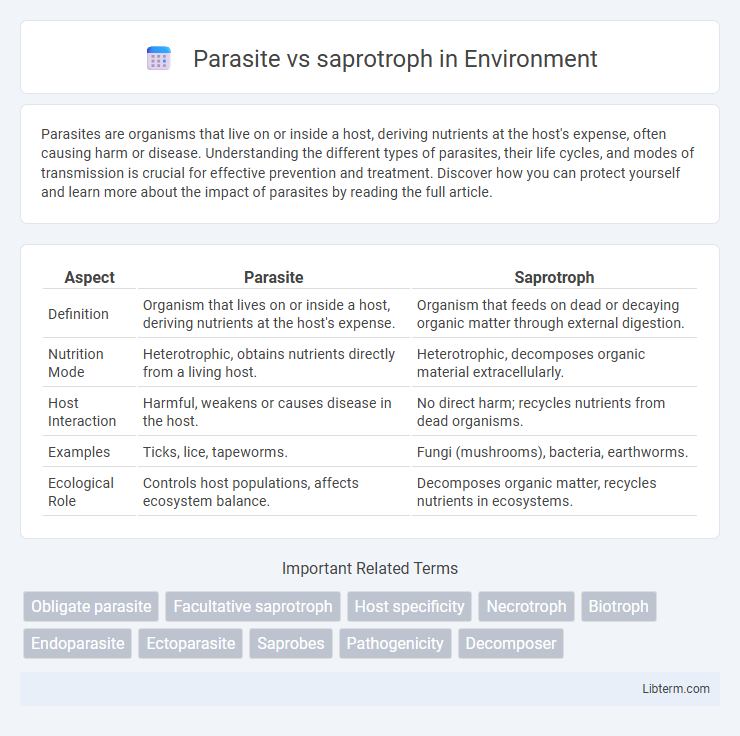Parasites are organisms that live on or inside a host, deriving nutrients at the host's expense, often causing harm or disease. Understanding the different types of parasites, their life cycles, and modes of transmission is crucial for effective prevention and treatment. Discover how you can protect yourself and learn more about the impact of parasites by reading the full article.
Table of Comparison
| Aspect | Parasite | Saprotroph |
|---|---|---|
| Definition | Organism that lives on or inside a host, deriving nutrients at the host's expense. | Organism that feeds on dead or decaying organic matter through external digestion. |
| Nutrition Mode | Heterotrophic, obtains nutrients directly from a living host. | Heterotrophic, decomposes organic material extracellularly. |
| Host Interaction | Harmful, weakens or causes disease in the host. | No direct harm; recycles nutrients from dead organisms. |
| Examples | Ticks, lice, tapeworms. | Fungi (mushrooms), bacteria, earthworms. |
| Ecological Role | Controls host populations, affects ecosystem balance. | Decomposes organic matter, recycles nutrients in ecosystems. |
Introduction to Parasites and Saprotrophs
Parasites are organisms that live on or inside a host, deriving nutrients at the host's expense and often causing harm. Saprotrophs obtain nutrients by decomposing dead organic matter, playing a crucial role in nutrient cycling and ecosystem health. Both parasites and saprotrophs contribute to ecological balance through distinct modes of nutrient acquisition.
Defining Parasites: Characteristics and Types
Parasites are organisms that live on or inside a host organism, deriving nutrients at the host's expense, often causing harm. Characterized by specialized adaptations such as attachment organs and immune evasion mechanisms, parasites can be classified into ectoparasites, which live on the host's surface, and endoparasites, which inhabit internal organs or tissues. Types of parasites include protozoa like Plasmodium, helminths such as tapeworms, and arthropods like ticks, each exhibiting unique life cycles and host interactions.
What Are Saprotrophs? Key Traits Explained
Saprotrophs are organisms that obtain nutrients by decomposing dead organic matter, playing a crucial role in nutrient cycling and ecosystem health. Key traits include secreting enzymes to break down complex organic materials externally before absorbing the simpler substances and thriving in environments rich in decaying plant or animal matter. Unlike parasites, saprotrophs do not feed on living hosts, instead contributing to decomposition and soil fertility.
Modes of Nutrition: Parasitic vs. Saprotrophic
Parasites obtain nutrients by living on or inside a host organism, deriving organic compounds directly from the host's tissues, often harming the host in the process. Saprotrophs secrete digestive enzymes to externally break down dead or decaying organic matter, absorbing the resulting nutrients for growth and energy. This fundamental difference in nutrient acquisition distinguishes the parasitic mode of nutrition from the saprotrophic mode in ecological systems.
Life Cycles and Adaptations
Parasites have complex life cycles involving multiple hosts, often adapting specialized structures like hooks or suckers for attachment and nutrient absorption from living organisms. Saprotrophs possess simpler life cycles, thriving on decomposing organic matter by secreting enzymes to break down dead tissue externally, without the need for a host. Adaptations in parasites include evasion of host immune responses, while saprotrophs focus on efficient extracellular digestion and nutrient uptake.
Ecological Roles in Nature
Parasites obtain nutrients by living on or inside a host organism, often causing harm and influencing host population dynamics and community structure. Saprotrophs, such as fungi and bacteria, decompose dead organic matter, recycling nutrients back into ecosystems and maintaining soil fertility. Both play crucial ecological roles by regulating energy flow and nutrient cycling, but parasites impact living hosts while saprotrophs focus on non-living organic material.
Impact on Host Organisms and Ecosystems
Parasites negatively impact host organisms by extracting nutrients, often causing diseases or weakened health, which can reduce host population sizes and biodiversity. Saprotrophs contribute positively by decomposing dead organic matter, recycling nutrients back into ecosystems, and supporting soil fertility and plant growth. The contrasting roles of parasites and saprotrophs shape ecological balance, with parasites regulating host populations and saprotrophs maintaining nutrient cycles essential for ecosystem stability.
Common Examples of Parasites and Saprotrophs
Common examples of parasites include tapeworms, lice, and mistletoe, which depend on host organisms for nutrients, often causing harm. Saprotrophs such as fungi, bacteria, and earthworms play a crucial role in ecosystems by decomposing dead organic matter and recycling nutrients back into the soil. Parasites typically live on or inside a living host, while saprotrophs thrive on decaying material.
Parasites vs. Saprotrophs: Key Differences
Parasites derive nutrients directly from living hosts, causing harm by exploiting their tissues, whereas saprotrophs obtain nutrients by decomposing dead organic matter without directly harming living organisms. Parasites often have specialized adaptations for attachment and nutrient absorption from hosts, contrasting with saprotrophs that secrete enzymes to break down complex organic materials externally before absorption. The ecological roles differ as parasites influence host population dynamics, while saprotrophs play a crucial role in nutrient cycling and ecosystem decomposition processes.
Importance and Applications in Biotechnology
Parasites and saprotrophs both play crucial roles in biotechnology due to their distinct mechanisms of nutrient acquisition and interaction with hosts or substrates. Parasites are essential in developing targeted biocontrol agents and vaccine research by exploiting their host-specific interactions, while saprotrophs contribute to waste decomposition, enzyme production, and bioremediation by breaking down organic matter. Understanding the molecular pathways of parasitism and saprotrophy enhances advancements in pharmaceuticals, agriculture, and environmental sustainability.
Parasite Infographic

 libterm.com
libterm.com